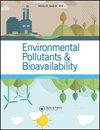东南热带山区深层饮用水水库沉积物中磷的时空分布、环境意义及释放风险
Q3 Chemical Engineering
引用次数: 1
摘要
摘要本研究首次采用化学萃取法对山美水库岩心沉积物中磷的分馏和分布进行了定向研究,以了解其生物利用度、吸附特性、潜在释放量及其环境意义。研究结果表明,沉积物中磷以无机磷(IP)为主,无机磷以非磷灰石磷(NAIP)为主。P组分的水平分布和时间分布各不相同,但垂直分布相似,呈先下降后稳定的趋势。3季沉积物中总磷(TP)、总磷(IP)、有机磷(OP)、无机磷(NAIP)、磷灰石磷(AP)和生物有效磷(BAP)含量分别为193.85 ~ 1664.05 mg·kg−1、126.90 ~ 1127.70 mg·kg−1、43.74 ~ 669.29 mg·kg−1、57.62 ~ 937.07 mg·kg−1、32.58 ~ 250.71 mg·kg−1和41.06 ~ 871.82 mg·kg−1。沉积物中NAIP含量占总磷的50%以上。从三个方面分析,富营养化风险指数(ERI)可用于评价沉积物中磷的潜在释放,山美水库沉积物中磷的释放风险较高。本文章由计算机程序翻译,如有差异,请以英文原文为准。
Temporal-spatial distribution, environmental significance and release risks of phosphorus in the sediments of a tropical mountain’s deep drinking water reservoir in southeastern China
Abstract In this study, the fractionation and distribution of phosphorus (P) in the core sediments of the Shanmei reservoir were investigated by using the chemical extraction method in directions for the first time in order to understand its bio-availability, adsorption characteristics, potential release and environmental significance. The results of the study showed that P in the sediments mainly consisted of inorganic phosphorus (IP) and that IP mainly consisted of non-apatite phosphorus (NAIP). The horizontal and temporal distributions of the P fractions were different from each other, but the vertical distribution was similar, which indicated a trend of stabilization after falling. The content of total phosphorus (TP), IP, organic phosphorus (OP), NAIP, apatite phosphorus (AP), and bio-available phosphorus (BAP) in the sediments during the three seasons ranged from 193.85 to 1664.05 mg·kg−1, 126.90 to 1127.70 mg·kg−1, 43.74 to 669.29 mg·kg−1, 57.62 to 937.07 mg·kg−1, 32.58 to 250.71 mg·kg−1, and 41.06 to 871.82 mg·kg−1, respectively. NAIP contents in the sediments accounted for more than 50% of TP. Using an analysis from three aspects, the eutrophication risk index (ERI) could be used to assess the potential release of P in the sediments, and there was a high release risk of P in the sediments in the Shanmei reservoir.
求助全文
通过发布文献求助,成功后即可免费获取论文全文。
去求助
来源期刊
CiteScore
1.62
自引率
0.00%
发文量
0
审稿时长
1 months
期刊介绍:
Chemical Speciation & Bioavailability ( CS&B) is a scholarly, peer-reviewed forum for insights on the chemical aspects of occurrence, distribution, transport, transformation, transfer, fate, and effects of substances in the environment and biota, and their impacts on the uptake of the substances by living organisms. Substances of interests include both beneficial and toxic ones, especially nutrients, heavy metals, persistent organic pollutants, and emerging contaminants, such as engineered nanomaterials, as well as pharmaceuticals and personal-care products as pollutants. It is the aim of this Journal to develop an international community of experienced colleagues to promote the research, discussion, review, and spread of information on chemical speciation and bioavailability, which is a topic of interest to researchers in many disciplines, including environmental, chemical, biological, food, medical, toxicology, and health sciences.
Key themes in the scope of the Journal include, but are not limited to, the following “6Ms”:
Methods for speciation analysis and the evaluation of bioavailability, especially the development, validation, and application of novel methods and techniques.
Media that sustain the processes of release, distribution, transformation, and transfer of chemical speciation; of particular interest are emerging contaminants, such as engineered nanomaterials, pharmaceuticals, and personal-care products.
Mobility of substance species in environment and biota, either spatially or temporally.
Matters that influence the chemical speciation and bioavailability, mainly environmentally relevant conditions.
Mechanisms that govern the transport, transformation, transfer, and fate of chemical speciation in the environment, and the biouptake of substances.
Models for the simulation of chemical speciation and bioavailability, and for the prediction of toxicity.
Chemical Speciation & Bioavailability is a fully open access journal. This means all submitted articles will, if accepted, be available for anyone to read, anywhere, at any time. immediately on publication. There are no charges for submission to this journal.

 求助内容:
求助内容: 应助结果提醒方式:
应助结果提醒方式:


